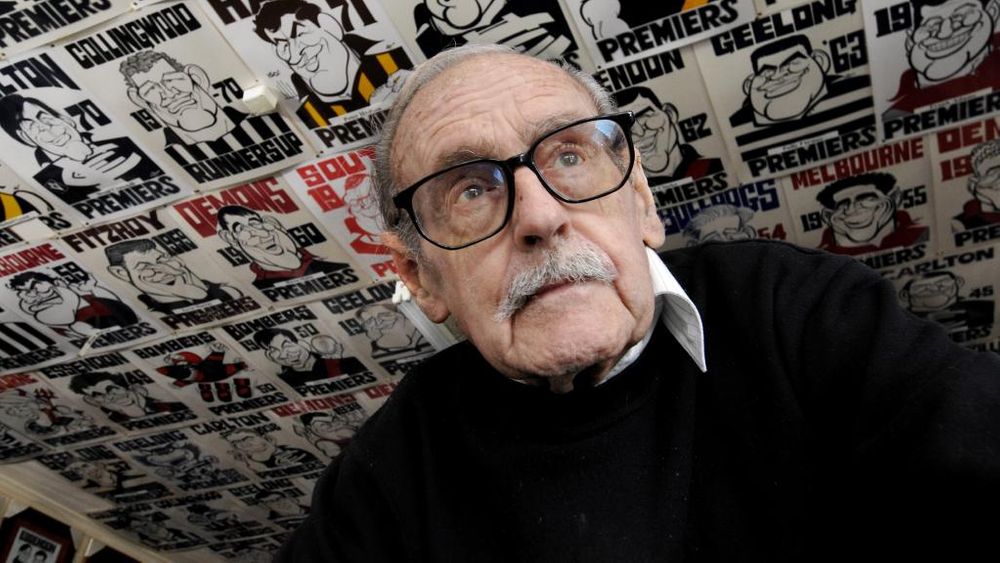William Ellis Green, OAM, was born on 12 August 1923 and died on 29 December 2008. He signed his cartoons “WEG”, was an Australian editorial cartoonist and illustrator who drew the Australian Football League premiership posters from 1954 until his death.
William Ellis Green
Born: August 12, 1923
Died: December 29, 2008
Known As: WEG (Cartoonist)
Occupation: Editorial Cartoonist and Illustrator
Notable Work: Australian Football League premiership posters (1954-2008)
Life and Career
William Ellis Green, known by his pen name “WEG,” was an Australian editorial cartoonist and illustrator. He was born on August 12, 1923, in the Melbourne suburb of Fitzroy. Green’s original name was Ian, but he legally changed it to William later in life. He grew up in Essendon and initially contemplated a career as an architect but ultimately pursued a path as a cartoonist.
In 1941, at the age of 18, Green enlisted in the Australian Army and was attached to the 15th Brigade Army Intelligence in New Guinea. During his service, he drew cartoons for the army’s newspaper. After World War II, he briefly resumed his architectural studies but eventually switched to a postwar rehabilitation art course at the National Gallery of Victoria.
Green’s talent as a cartoonist became evident when he submitted cartoons to The Herald. He filled in for the paper’s political cartoonist, Sammy Wells, in 1946 and impressed the editor-in-chief, John Williams. In 1947, he joined The Herald staff permanently and continued to work as a political cartoonist for the paper until his retirement in 1986.
One of Green’s notable contributions was the introduction of the daily “pocket” cartoon Weg’s Day, which featured single-column topical commentary presented humorously. It appeared on the paper’s front page for 38 years.
On May 14, 1949, Green married Joan Hettie Currell in Milton, Queensland.
Even after retiring from political cartooning, Green continued to work as a caricaturist and illustrator. His work appeared in cricket books, on stamps, and in children’s books.
Premiership Posters
Starting in the 1954 VFL season, William Ellis Green began drawing premiership posters for the winning teams of the Victorian Football League (VFL) Grand Final. Initially published in the Weekend Herald, Green’s posters became immensely popular, and by 1966, The Herald started producing and selling them after each grand final. These posters typically featured caricatures of the winning club’s mascot.
Green’s dedication to this tradition was remarkable. He produced posters not only for the seasons since 1954 but also for earlier years, dating back to 1897, to satisfy collectors. An exhibition of all 55 of Green’s original posters was held at the National Sports Museum in 2009.
After Green’s passing in 2008, Herald Sun cartoonist Mark Knight took over as the illustrator of the posters, continuing the tradition. Green’s family releases a grand final poster each year in his memory, using artwork supplied by Green himself before his death. His private company, Weg Art, continues to supply the posters annually.
Later Life and Honours
In his later years, William Ellis Green became known for a remarkable incident in which he confronted a burglar in his backyard in Heathmont, Victoria, in January 2005, at the age of 82. After confronting the intruder, Green not only called the police but also sketched a caricature of the burglar. His art proved instrumental in identifying the culprit, who was soon apprehended.
Green passed away on December 29, 2008, at Maroondah Hospital. He was survived by his wife Joan, daughter Lynette, and son Ian.
Honours:
- Medal of the Order of Australia (2001) for service to art as a cartoonist and illustrator, and to the community, particularly through the Good Friday Appeal of the Royal Children’s Hospital.
- Jim Russell Award (2003) from the Australian Cartoonists’ Association in acknowledgment of his lifelong contribution to the profession of cartooning.
- Quill Award for Lifetime Achievement (2009) from the Melbourne Press Club, posthumously bestowed on him.
William Ellis Green’s personal life
William Ellis Green’s original name was Ian; he later legally changed it to William. Born in the Melbourne suburb of Fitzroy on 12 August 1923 to an unknown father, William Ellis Green grew up in Essendon. Torn between becoming an architect or a cartoonist after leaving Essendon High School, he studied architecture at the Melbourne Technical College because his mother warned: “You’ll starve if you’re a cartoonist.” At the age of 18, he enlisted in the Australian Army and was attached to the 15th Brigade, Army Intelligence in New Guinea. On 14 May 1949, Green married Joan Hettie Currell in Milton, Queensland. His wife’s name was Joan, and he had a daughter (Lynette)and a son (Ian).

Professional life
Green continued working as a caricaturist and illustrator, with his work appearing in cricket books by Max Walker, on stamps, and in children’s books. At the age of 18, he enlisted in the Australian Army and was attached to the 15th Brigade, Army Intelligence in New Guinea. He drew cartoons that were published in the army’s newspaper.

Following his discharge from the army at the end of World War II, Green resumed his architectural studies, but he abandoned architecture in favor of a postwar rehabilitation art course at the National Gallery of Victoria, where his tutors included Sir William Dargie. During this time he submitted cartoons to The Herald. When the paper’s political cartoonist, Sammy Wells, went on holiday for six weeks in 1946, Green was asked to fill in for him. His work appealed to the editor-in-chief, John Williams.

In 1947 he was invited to join The Herald staff permanently. He continued to be a political cartoonist for the paper until he retired in 1986, after 40 years in that role. William Ellis Green was responsible for introducing the daily “pocket” cartoon, Weg’s Day, a single column topical comment humorously presented, that appeared for the first time in 1949 and continued on the paper’s front page for 38 years.

Premiership posters
In the 1954 VFL season, William Ellis Green began drawing premiership posters of the winning teams of the Victorian Football League (VFL) Grand Final for the Weekend Herald. By 1966, Green’s posters had become so popular that The Herald started producing and selling them after the grand final. The posters, generally featuring a caricature of the winning club’s mascot smiling gleefully, continued to sell around 100,000 copies each year. Although the series started in 1954, Green produced posters for all the grand finals back to 1897 to satisfy collectors. An exhibition of all 55 of Green’s original posters was staged at the National Sports Museum in 2009.

The tradition continued after Green’s death, with Herald Sun cartoonist Mark Knight taking over as the illustrator of the posters from 2009. The family of the late cartoonist releases a grand final poster every year in his memory from artwork supply by Green before he died. He told the family that he wanted his posters to go on after he was gone. His private company, Weg Art, supplies the posters each year.

Honor
In June 2001, Green received the Medal of the Order of Australia “for service to art as a cartoonist and illustrator, and to the community, particularly through the Good Friday Appeal of the Royal Children’s Hospital.” In 2003, he received the Jim Russell Award from the Australian Cartoonists Association in acknowledgment of his lifelong contribution to the profession of cartooning. In 2009 the Melbourne Press Club posthumously bestowed on him the Quill Award for Lifetime Achievement.
Later life and death
On 14 January 2005, the 82-year-old William Ellis Green confronted a burglar running through his backyard in Heathmont, Victoria. After confronting the man, William Ellis Green called the police and then proceeded to take pen to paper and produce a caricature. His art was immediately recognizable to the local police. The offender was soon apprehended at a local shop, as the cartoon clearly showed the man responsible. Green died on 29 December 2008 at the Maroondah Hospital; he was survived by his wife Joan, daughter Lynette and son Ian.
Frequently Asked Questions (FAQ) about William Ellis Green (WEG)
1. Who was William Ellis Green, and what was his significance in art and illustration?
William Ellis Green, known by his pen name “WEG,” was an Australian editorial cartoonist and illustrator. He gained prominence for his editorial cartoons, and is particularly famous for drawing the Australian Football League (AFL) premiership posters from 1954 until his passing in 2008.
2. When and where was William Ellis Green born?
William Ellis Green was born on August 12, 1923, in the Melbourne suburb of Fitzroy, Australia.
3. What was WEG’s original name, and why did he change it?
WEG’s original name was Ian, but he legally changed it to William.
4. Can you tell me about his early life and education?
From a young age, Green grew up in Essendon, Australia, and had a passion for cartooning. He was torn between pursuing a career as an architect or a cartoonist, but ultimately chose architecture. He studied architecture at Melbourne Technical College, but later switched to a postwar rehabilitation art course at the National Gallery of Victoria after World War II.
5. What was WEG’s military service during World War II?
In 1941, at 18, William Ellis Green enlisted in the Australian Army and was attached to the 15th Brigade, Army Intelligence in New Guinea. He drew cartoons that were published in the army’s newspaper.
6. When did WEG start his career in cartooning, and where did he work?
After World War II, Green resumed his studies but abandoned architecture to pursue a career in cartooning. He submitted cartoons to The Herald newspaper and filled in for the paper’s political cartoonist, Sammy Wells, in 1946. His work impressed the editor-in-chief, John Williams, and he was invited to join The Herald staff permanently in 1947. He continued to work as a political cartoonist for the paper until his retirement in 1986.
7. What was WEG’s contribution to The Herald newspaper?
William Ellis Green introduced the daily “pocket” cartoon called “Weg’s Day,” which featured a single-column topical comment presented with humor. This cartoon appeared on the newspaper’s front page for 38 years, starting in 1949.
8. Did WEG have a family, and when did he get married?
William Ellis Green married Joan Hettie Currell in Milton, Queensland, on May 14, 1949. They had a daughter named Lynette and a son named Ian.
9. What are WEG’s famous works apart from political cartoons?
In addition to his political cartoons, WEG’s illustrations appeared in cricket books by Max Walker, on stamps, and in children’s books.
10. What is WEG’s legacy in the context of the AFL premiership posters?
William Ellis Green began drawing premiership posters for the Victorian Football League (VFL) Grand Final winning teams in 1954. These posters featured caricatures of the winning club’s mascots and became extremely popular. The tradition of creating these posters continued even after his death, with Herald Sun cartoonist Mark Knight taking over as the illustrator in 2009.
11. What honors and awards did WEG receive during his lifetime?
WEG received several honors and awards during his lifetime. In 2001, he was awarded the Medal of the Order of Australia for his service to art as a cartoonist and illustrator and his contributions to the community, mainly through the Good Friday Appeal of the Royal Children’s Hospital. In 2003, he received the Jim Russell Award from the Australian Cartoonists’ Association for his lifelong contribution to cartooning. Posthumously, in 2009, the Melbourne Press Club gave him the Quill Award for Lifetime Achievement.
12. When did William Ellis Green pass away, and what were the circumstances of his death?
William Ellis Green died at Maroondah Hospital on December 29, 2008. His wife Joan, daughter Lynette, and son Ian survived him.
Please note that this FAQ is based on the provided information and may not cover all aspects of WEG’s life and career.
This post was created with our nice and easy submission form. Create your post!





2 Comments